Ten days in St. Lucia and no time to write. Relaxing and sightseeing took up too much energy. Now, our bags are packed and we're ready to go. I can write about St. Lucia from with a little perspective. (Check out all the St. Lucia Pictures)
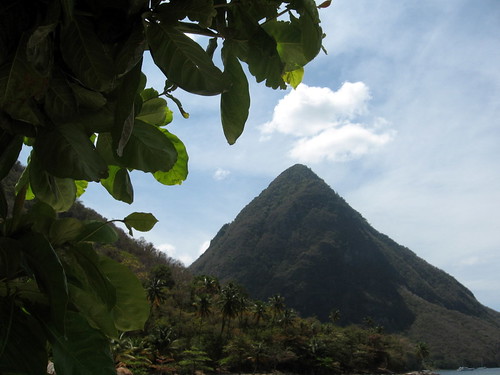 We were based on Moule a Chique, a hilly peninsula that is the south tip of the Island, in a 6-room guest house called Villa Caribbean Dream. Most of the all-inclusive resorts are on the west (Caribbean Sea) coast, at least a half-hour drive from here. Moule a Chique is part of the town of Vieux Fort, a small port city, where the main attraction for the few tourists that are here is Anse de Sable, a beach that draws kitesurfers and windsurfers from around the world (well -- primarily Europe and North America).
We were based on Moule a Chique, a hilly peninsula that is the south tip of the Island, in a 6-room guest house called Villa Caribbean Dream. Most of the all-inclusive resorts are on the west (Caribbean Sea) coast, at least a half-hour drive from here. Moule a Chique is part of the town of Vieux Fort, a small port city, where the main attraction for the few tourists that are here is Anse de Sable, a beach that draws kitesurfers and windsurfers from around the world (well -- primarily Europe and North America). Vieux Fort is dominated by poverty. The center of town is run down, but the buildings hint at a more prosperous past. Shops carry clothing aimed at the local market, convenience goods, some food, beauty products and other essentials. The few restaurants are uninspired. Street vendors hawk sweet potatoes, ginger, bananas, cinnamon. The chinese restaurant was a surprise, but by the time we got there one evening, hoping for dinner, most of the food was gone, and what was left didn't look too appetizing.
There are few white people here. While in the town itself, we might not pass another white person. The Chinese restaurant is run by Chinese people, but we didn't see a single Chinese person on our entire journey. Every once in awhile you see someone who appears to be of Indian (from India) descent. We learned that after slavery ended here, the colonialists brought Indians over for three years of indentured labor, and some stayed after their contract.
The day after we got here, we took an opportunity to walk through town. While no one was hostile, we were clearly outsiders. Most people when we said a bright "hello!", but we didn't get many warm and fuzzies. We were outsiders and we felt like outsiders. I had my camera with me, but didn't feel comfortable taking any pictures. The chasm between our priviliged lives and what we saw on the streets was just too extreme. We did feel like intruders. At least I did.
Conditons improve as you ascend Moule a Chique, which is primarily an expat community, and primarily white (except for the help). The houses range from pleasant cottages to grander compounds. All with guard dogs. A winding steep narrow road leads up the hill to our guest house, and further up the hill is a lighthouse with specacular views.
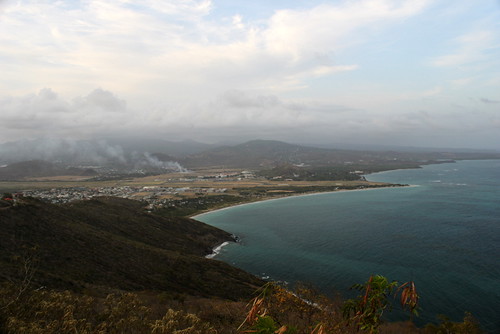 For the visitor (aka tourist), the highlight of the region is Anse de Sables, a sandy cove just below Moule a Chique. It's a simple beach, but the water is warm and clean. The steady winds make it a destination for kitesurfers, with a few windsurfers thrown in for good measure. We don't do either, so Susan and I were part of the read-and-swim brigade. Anchoring the cove is The Reef, and simple restaurant and bar, with a kitesurfing/windsurfing shop attached. Pull up a chair, have a Piton (the local beer), and hang out all day. Check e-mail, check wind forecasts, or Skype with people around the world if you want, beause they have WIFI. At around 3:00 in the afternoon, the airplanes started to depart the airport, which was about 100 yards behind us. One every half hour or so, perhaps 6 departures a day. We got to know the departure schedule pretty well. With so few departures, the noise was not an issue at all.
For the visitor (aka tourist), the highlight of the region is Anse de Sables, a sandy cove just below Moule a Chique. It's a simple beach, but the water is warm and clean. The steady winds make it a destination for kitesurfers, with a few windsurfers thrown in for good measure. We don't do either, so Susan and I were part of the read-and-swim brigade. Anchoring the cove is The Reef, and simple restaurant and bar, with a kitesurfing/windsurfing shop attached. Pull up a chair, have a Piton (the local beer), and hang out all day. Check e-mail, check wind forecasts, or Skype with people around the world if you want, beause they have WIFI. At around 3:00 in the afternoon, the airplanes started to depart the airport, which was about 100 yards behind us. One every half hour or so, perhaps 6 departures a day. We got to know the departure schedule pretty well. With so few departures, the noise was not an issue at all.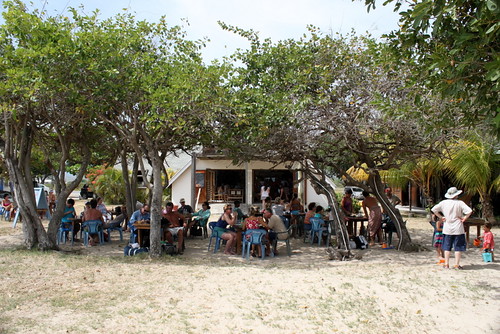 I'd estimate there were 30-50 tourists on the south end of St. Lucia, and they all hung out at The Reef. (There was also an all-inclusive resort nearby, but we never saw anyone from there, as they were eating and drinking their unlimited food on-site). Day after day we saw the same people, and over time, we all knew each other. The atmosphere was laid back. No one was in a hurry to do anything. The wind-people patiently waited for their wind -- for days and days. On some days, kites lined the beach, in eager anticipation of enough wind to make windsurfing possible. It seemed plenty breezy to us, but we learned that 12-16 knots was marginal, and that 16-24 was really needed. Eager kiters held wind gauges aloft, hoping for good news, but in our ten days, there was only one of full blown action, where 9 kiters were out all at once. Another day saw three or four have a go, and one day had some trying in less than ideal wind, and struggle mightily.
I'd estimate there were 30-50 tourists on the south end of St. Lucia, and they all hung out at The Reef. (There was also an all-inclusive resort nearby, but we never saw anyone from there, as they were eating and drinking their unlimited food on-site). Day after day we saw the same people, and over time, we all knew each other. The atmosphere was laid back. No one was in a hurry to do anything. The wind-people patiently waited for their wind -- for days and days. On some days, kites lined the beach, in eager anticipation of enough wind to make windsurfing possible. It seemed plenty breezy to us, but we learned that 12-16 knots was marginal, and that 16-24 was really needed. Eager kiters held wind gauges aloft, hoping for good news, but in our ten days, there was only one of full blown action, where 9 kiters were out all at once. Another day saw three or four have a go, and one day had some trying in less than ideal wind, and struggle mightily.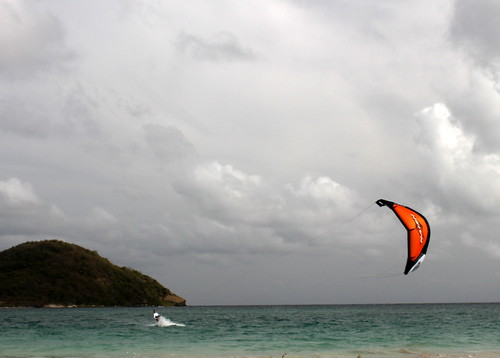 It was an international crowd. Dutch, Russian, French, Swedish, Belgian, German, British, Australian, Canadian and American. Perhaps a few others. The kiters all helped each other out. Many stayed right on the beach in glorified shacks within walking distance of The Reef, with no cars, so they had breakfast, lunch and dinner there, plus their drinks. Some were fixtures, with laptops open on the tables all day while they sunbathed, read, or otherwise occupied themselves.
It was an international crowd. Dutch, Russian, French, Swedish, Belgian, German, British, Australian, Canadian and American. Perhaps a few others. The kiters all helped each other out. Many stayed right on the beach in glorified shacks within walking distance of The Reef, with no cars, so they had breakfast, lunch and dinner there, plus their drinks. Some were fixtures, with laptops open on the tables all day while they sunbathed, read, or otherwise occupied themselves. The staff at The Reef were laid back and friendly. They'd run a tab for us on a plain pad of scrap-paper. The food was filling and good, and the prices were decent. Though some locals seemed to come by, the customers were by and large of the tourist variety.
The beach was segregated. The tourists frequented the Reef. Twenty feet down the beach was another bar, that attracted the locals. I ddin't see a single tourist there, and from the local bar to the end of the beach was dominated by locals. Sociology at work. Funny how the tourists all seem to follow the lead of the others that have been there a few days more.
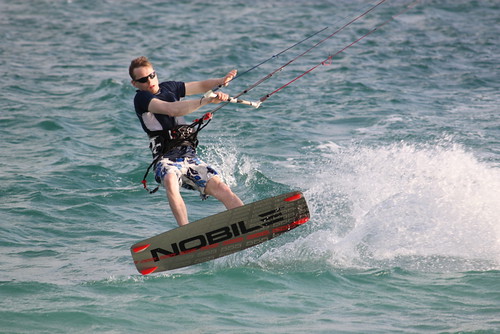 It would have been easy to stay perched at the Reef for ten days, and there were those that did. After a couple of days hoping to get by on foot and taxi, we broke down and rented a car, to get out and see some of the Island. In search of an elusive coastal hiking trail marked clearly on our tourst map, but not so clearly in the real world, we happened upon the town of Dennery on the east coast. Cresting a hill, we were mesmerized by what looked to be a vibrant, colorful town rising from a protected bay. I imagined a wealthy community drawn to the natural beauty of the surroundings. What we found upon entering Dennery in search of lunch was a ramshackle fishing village, far from the tourist trade. The colorful buildings we had spied from a distance ranged from falling-down hovels to small shacks barely keeping it togther.
It would have been easy to stay perched at the Reef for ten days, and there were those that did. After a couple of days hoping to get by on foot and taxi, we broke down and rented a car, to get out and see some of the Island. In search of an elusive coastal hiking trail marked clearly on our tourst map, but not so clearly in the real world, we happened upon the town of Dennery on the east coast. Cresting a hill, we were mesmerized by what looked to be a vibrant, colorful town rising from a protected bay. I imagined a wealthy community drawn to the natural beauty of the surroundings. What we found upon entering Dennery in search of lunch was a ramshackle fishing village, far from the tourist trade. The colorful buildings we had spied from a distance ranged from falling-down hovels to small shacks barely keeping it togther.One narrow road led into Dennery town, with the focus of activity the fishing port, with a dozen our so small fishing boats. Dominating the hillside was the church, by far the best kept building in town. The contrast was striking. Virtually every other building in town was in dire need of paint and repair, but the church was in perfect condition. Something seemed wrong about that picture, but who am I to judge? We saw the same contrast in each of the other towns on the island too.
The single lunch choice was The Laughing Fish, a ramshackle building with three picnic tables and a small kitchen in the back. One of the tables was occupied by three boisterous men drinking Campari. Approaching the kitchen window, we startled the Rastafari man behind the counter. Susan quickly surmised, out loud, that he must have been surprised to see customers, and white ones at that. Which gave us all a good laugh. Our host told us that lunch was cooking, and that it would be ready in 15 or 20 minutes. Little did we know that the chalkboard menu outside – fish, rice, lentils, macaroni and cheese – were not choices, but the single meal available. After a little walk up the hill, we returned to find the boisterous table even more so, and the food not quite ready. We were slowly getting on Island Time, we weren't starving, and were happy to chill in the shade. The fish was fresh and plainly cooked, fried in a little batter. We didn't know what it was, and found that the kind of fish was rarely mentioned in the restaurants. It was just – fish. The lentils were lightly seasoned and tasty, as was the rice. The mac and cheese seemed out of place, and redundant, but I'd never been much of a mac and cheese guy.
The west side of the island had more to attract tourists with Souffriere the anchor town. Sulpher hot springs served as a release valve for the still bubbling volcano that created the island. The water was hot hot hot – they said between 104 and 108 degrees farenheit, but I'm pretty sure it was at the higher end. Susan could't get in, and we could understand why they had a sign that said, “no refunds”. The water was a grey sludge, full of minerals that change from day to day. I only stayed for five or ten minutes, and was happy for the clear shower.
South of Souffriere were the Pitons, the iconic symbols of St. Lucia that are really volcanic con-shaped plugs that emerged from the ground not that long ago geologically – a few hundred thousand years. The actual mountains are visible from much of the island and pictures are visible all over the island on the Piton beer that's available everywhere. The larger one, Gros Piton, is climbable with a local guide, while the smaller, steeper one, Petit Piton, is not.
Souffriere is in the unhappy position of being a magnet for tourists, but they don't stay long. Tourists are bussed in from the resorts and cruise ships, and sent off to the attractions with little time to actually spend in town. As a result, walking the streets we found lots of people wanting to help us find our way, be our guide, in exchange for a tip. They were persistent and annoying but would eventually go away.


On our visit to Souffriere we happened to visit two resorts – Jalousie, which is nestled in a cove (anse) between the two Pitons and Anse Chastenet, which is accessible only by a narrow, steep, winding road (that we were advised to avoid) or water taxi. Little did we know that both of these were to be featured the next day on the TV show The Bachelor. Anse Chastenet was supposed to be the most magnificent beach on the island, but Susan and I both agreed that the distinction belongs to the south coast, Anse du Sable, where we spent most of our time.
The mixture of anchoring ourselves at The Reef and wandering the island worked well for us. Wandering the island was tiring. We rented a teeny tiny car that barely fit one large suitcase , struggled up the hills, and was easily passed by the buses (really mini-buses – think Econoline van size) that were packed to the edges with 10-15 people and easily passed us going up hill. Signs were not always around, so, navigatigng was a chore. And it was hot. While we had A/C, no one seemed to use it much, and it would have slowed us down on the hills. So we always made sure to include a swim on the daily itinerary.




Great travelogue! I daresay the 6 planes a day were priming you for a visit to Memphis, where airplane noise is the backdrop of our life. Not the horrible, deafening airplane noise of East Boston, but definitely omni-present when the FedEx planes are bringing their packages-and revenue-into the city at night.
ReplyDeleteYour vivid descriptions and interesting perspective make it worth waiting to read. Safe travels! Have fun! Bon voyage!
Claire